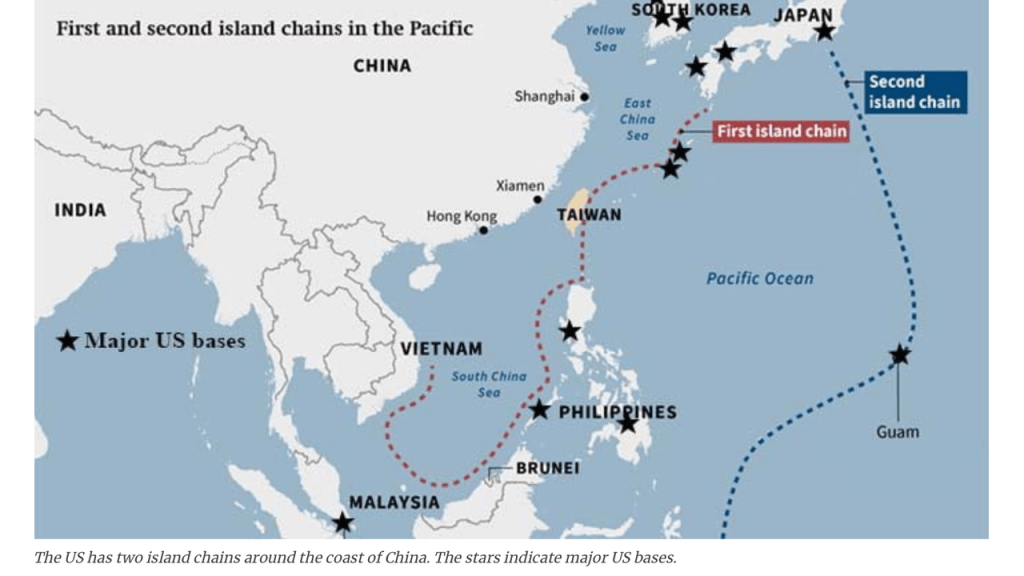As global attention focuses on China and Japan, Tokyo and Manila are quietly deepening their economic and “defense” ties.
Tag: Island Chain Strategy
Manila Recovers Chinese Underwater Drone Operating in Philippine Waters
[Aaron-Matthew Lariosa, 10-01-2025] Manila Recovers Chinese Underwater Drone Operating in Philippine Waters
Read More »PH: SCS Reconnaissance, Typhon, CADC, Oil wars
West PH Sea: US Navy ship spotted near Scarborough amid China ‘patrol’
MANILA, Philippines — A United States Naval Ship (USNS) was spotted near the country’s landmass while China Coast Guard (CCG) was conducting what it considers as a patrol around Panatag (Scarborough) Shoal on Sunday morning, a West Philippine Sea monitor said.
Read More »
[2016] A review of RAND Corporation’s ‘War with China: Thinking Through the Unthinkable’
This didn’t age well.
A review of RAND Corporation’s ‘War with China: Thinking Through the Unthinkable’
Read More »[11-26-2024] Sources for the Indian Ocean: Bay of Bengal & Strait of Malacca
Originally posted on Tuesday, November 26, 2024.
Search for “Bay of Bengal” in this document: Bangladesh and Kenya.
Read More »Bangladesh mission in India attacked: Why are ties in freefall?

Bangladesh mission in India attacked: Why are ties in freefall?
I wonder why?* /s
Related:
Read More »Japan’s Ground-Based Air Defense Options to the Philippines
Japan’s Ground-Based Air Defense Options to the Philippines
Bilateral defense relations between Japan and the Philippines come at an all-time high, signifying the continuous cooperation between both maritime nations that share a common adversary and similar situation regarding territorial domains and integrity in the Indo-Pacific region.
…
With the success of the export of the aforementioned radar systems to the Philippines from Japan, the latter is now raising up an idea of the likelihood of selling its surface-to-air missile batteries for the Philippine military to consider, with a wide variety of variants coming from the Japan Ground Self-Defense Force that might find its way for the likes of the Philippine Air Force. This is especially in line with the recently passed New Government Procurement Act or NGPA (Republic Act 12009), allowing the purchase of second-hand military hardware, provided it is economically preferable to the government.
Why Are There Fears of War in the South China Sea?
South China Sea: Philippines’ anti-ship missile base puts Scarborough Shoal in cross hairs (more information)
What the article left out is; to shoot far, the Philippine military needs to see far. However, the Philippines don’t have any over-the-horizon (OTH) radar, military satellites, AWACS planes or other long-range ISR capabilities, to make use of the full range of the BrahMos missile. Without it the missile is limited to the range of its available ISR assets, which are measured in just dozens of kilometers.
However, if a BrahMos missile is ever launched against a long-range Chinese target, it will be easy to guess who would have supplied the essential Intelligence, Surveillance, and Reconnaissance (ISR) information and target identification to the Philippine military.
South China Sea: Philippines’ anti-ship missile base puts Scarborough Shoal in cross hairs
Even if the Philippines lacks the advanced communications, intelligence, and targeting systems needed to maximise the BrahMos’ capabilities, it could still leverage US support in these areas, Koh said, citing the sinking of Russia’s Moskva warship by Ukraine in 2022, which he said was achieved thanks to “targeting support provided by Kyiv’s allies, chiefly the Americans”.
The flagship of Russia’s Black Sea Fleet, the Moskva became the largest warship lost in combat since the second world war when it was hit by two Ukrainian Neptune anti-ship missiles in April 2022. US officials later told the media that the Pentagon had provided intelligence that led to the ship’s sinking.
For the Philippines, the BrahMos missiles are “significant game changers” [🙄], according to security strategist Chester Cabalza, president of the International Development and Security Cooperation think tank in Manila.
…
However, Don McLain Gill, an international-studies lecturer at De La Salle University in the Philippines, questioned whether the BrahMos purchase alone would deliver robust deterrence against China.
“It will be crucial for the BrahMos to be supplemented by efficient intelligence, surveillance, target-acquisition and reconnaissance, which is critical to track targets and ensure they can be used by command,” he said, warning Manila must invest further to maximise the missiles’ deterrent value.
Previously:
Philippines Builds First BrahMos Anti-Ship Missile Base Facing South China Sea
[2021] Littoral Combat Ships for Maritime COIN
The LCS has just what the Navy needs to defend freedom of the seas in the first island chain.
Littoral Combat Ships for Maritime COIN
Previously:
Littoral Combat Ship Still Fighting to Prove Its Worth
Bringing Vietnamese Counterinsurgency To The Philippines And South China Sea (Part I) – Analysis


You must be logged in to post a comment.